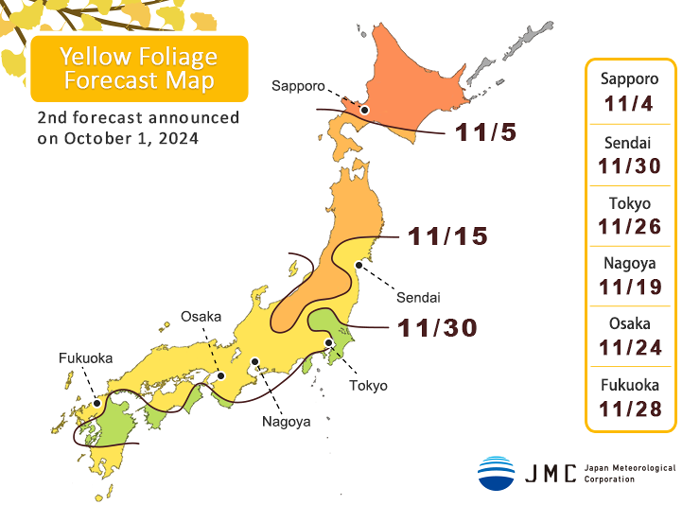Ginkgo Biloba: Fall Season Golden Foliage
Sacred Trees And Icho Namiki Alleys
The ginkgo biloba (銀杏 ichô) is a sacred tree traditionally planted in temples and shrines’ grounds, and is a symbol of the autumn season in Japan as much as the maple trees and their reddening foliage. Ginkgo leaves’ color turn into a bright yellow-gold in fall.
Originating from the mountains of South China, ginkgoes were contemporary to dinosaurs. Vigorous and rustic, and being a multi-stemmed tree, it can live up to several hundred years. It has a good resistance against climatic variations, fires 🔥 and urban pollution and it was the first tree species to grow back in Hiroshima after 1945’s atomic bombing.
The fan-shaped ginkgo leaf reminds of the letter T. It is one of Tokyo’s official symbols and has been selected in 1989 as the logo of the Tokyo Metropolitan Government. It is also a symbol of prosperity and it image is used in shrines dedicated to financial success, such as Mikane-jinja in Kyoto.

The ginkgo biloba is also known for its medicinal properties and has long been used in the Japanese pharmacopoeia. Its edible nuts (ginnan) are rich in vitamine C and carotene, and are usually sold already cooked and canned, for stewing in a nabe hot pot or for grilling on skewers. They can be eaten fresh at harvest time with a pinch of salt, like edamame beans with an aperitif.
When is the season of the yellow leaves?
In autumn, people pay now as much attention to the green foliage gradually turning into golden yellow as they do to the reddening of the momiji 🍁 maple trees. The JMC (Japan Meteorological Corporation) has an official meteorological forecast and the peak of the yellow leaves usually happens a few days before the maple’s.
For 2024 koyo, the best time to see ginkgoes in Tokyo, Kyoto or Osaka is set around November 26. The areas in the north of Japan (Hokkaido and Tohoku) display their golden leaves during the 1rst half of November.

Where to see the ginkgoes alleys in Tokyo?
Ginkgoes’ golden brightness particularly enhances the avenues of Tokyo in autumn. The capital has several large ginkgo trees alleys (called 銀杏並木 or いちょう並木 icho namiki in Japanese), that become popular koyo spots during the peak of the yellow leaves.
The ginkgo biloba started to embellish Tokyo’s cityscape at the beginning of the 20th century, when professor Seiroku Honda (1862 - 1952) designed the 1rst ginkgo alley for Todai University campus, that still exists nowadays. There are several popular ginkgo avenues in the capital:
- Icho Namiki, in Meiji Jingu Gaien Park, the most famous with about 150 trees, laid out in double lines (Aoyama-Itchome station);
- The ginkgoes in front of the Diet Building (Sakuradamon station);
- The historical alley leading to Yasuda Auditorium at Tokyo University (Todaimae station);
- The ginkgo bilobas lining up the moats of the Imperial Palace (Gyoko-dori) in Marunouchi district (Nijubashimae station);
- The walkway leading to Yasukuni-jinja shrine (Kudanshita station);
- The Platinum-dori avenue (between Meguro-dori and Gaien Nishi-dori) in Shirokanedai;
- Kita-dori street in Nishi-Shinjuku near the skyscrapers’ area of the Cocoon Tower (Shinjuku-nishiguchi station).

The parks of the capital also have icho namiki alleys, like:
- Yoyogi Park in Shibuya;
- Hibiya Park in Chiyoda;
- Yokoamicho Park in Ryokogu;
- Otaguro Park in Suginami ward;
- Hikarigaoka Park in Nerima;
- Komazawa Olympic Park and Hanegi Koen in Setagaya;
- Showa Memorial Park in Tachikawa.
Tokyo’s oldest ginkgo tree is more than 700 years old and is growing in Zenpuku-ji temple’s grounds, in Azabu district.
A ginkgo festival called Hachioji Icho Matsuri (八王子いちょう祭り) is held every year, on a weekend in mid-November in the vicinity of Takao Station in the west of Tokyo. 770 trees have been planted along the former Edo Koshu Kaido road during the Showa Era (1926 - 1989).
The best ginkgo spot in Japan
We have made a non-exhaustive short list of the most beautiful places to watch the fall changing colors of the ginkgo biloba trees in the archipelago:
Ancient sacred trees
- Aomori:
- Giant ginkgo in Kita-Kanegasawa in Fukaura, one of Japan’s tallest and oldest specimens,
- Horyo’s gingko near Oirase Gorge and National Road 102 in Towada;
- Saitama: 700 years old ginkgo at Shobo-ji in Higashimatsuyama;
- Chiba: 1,200 years old tree at Katsushika Hachiman-gu in Ichikawa (Yawata station);
- Kyoto: 400 years old ginkgo at the Nishi Hongan-ji and several other trees in the enclosure of the Higashi Hongan-ji;
- Okayama: 600 years old ginkgo at Kibitsu-jinja;
- Shimane: 600 years old ginkgo at the Jozen-ji near Mount Sanbe in Oda;
- Kumamoto: an over 1,000 years old ginkgo near Nabekama Waterfalls in Shimojo in Kurokawa Onsen’s area.
Gingkos forests and alleys
- Sapporo: alley on the campus of Hokkaido University (Hokudai, Kitajunijo station);
- Fukushima: an 116 trees line at the Azuma Sports Park;
- Nagoya: 10,000 trees between Yusen-ji temple and Sobue Ginnan Park in Inazawa (Yamazaki station) celebrated by the Sobue Icho Koyo Matsuri festival and its night illuminations;
- Osaka: along Midosuji Boulevard in the heart of the city center (Yodoyabashi, Hommachi or Shinsaibashi station) and the Castle 🏯’s Park (Osakajokoen station);
- Kyoto: along the Horikawa-dori avenue near Horikawa Seseragi Park (Kitaoji Horikawa bus stop);
- Nara: trees are growing around the Daibutsu-ike pond near Todai-ji temple and in the park where deer are living freely;
- Himeji: along the Otemae-dori road connecting the station to the castle;
- Kagoshima: a 1,000 ginkgoes private garden in Tarumizu (垂水千本イチョウ園 Tarumizu Senbon Icho-en).


